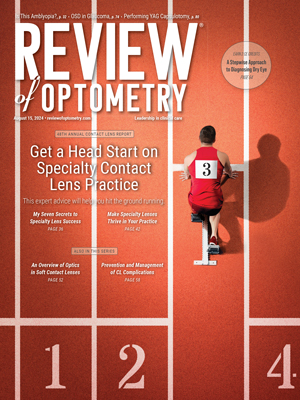
Q: I have several patients in their 30s and 40s who become intolerant to contact lens wear, after 15 to 20 years of success. Many are gas permeable lens wearers. Why does this happen, and what can I do about it?
A: There are four possible reasons for this phenomenon:
Some of these patients are borderline for dry eye. A great majority of people are able to wear their contact lenses through their older years, says optometrist Edward S. Bennett, of the Univer-sity of Missouri-St. Louis College of Optometry. As such, he believes individuals who become intolerant were probably borderline dry eye individuals who went over the threshold, in that as their tear volume decreased, they just became intolerant. Dr. Bennett has found this to be true in both gas permeable and soft contact lens wearers.
His solution: Fit these patients in the most wettable materials available. I like to use the low Dk/t fluorosilicone acrylate gas permeable lenses and the daily disposable soft lenses, he says.
Corneal trauma. This is one of two possible culprits behind reduced tear volume, says William D. Mathers, M.D., of the Casey Eye Institute at Oregon Health & Science University in Portland. If you stimulate the cornea, you would think that tear production would increase, and to a certain extent it does, he says. In the molecular studies, however, there is a stress response that occurs in the lacrimal gland to corneal trauma, he says, and this response acts to reduce tear production. Contact lenses can often induce an element of corneal trauma, Dr. Mathers adds. He suggests prescribing artificial tears and dry eye medications to these patients.

Recurrent corneal erosion syndrome (RCE), as seen above, may be responsible for sudden contact lens intolerance.
Recurrent corneal erosion (RCE) syndrome. Dr. Mathers believes a reduction in tears may also be caused by RCE. In patients who have RCE, the adhesion of the epithelium to the underlying stroma destabilizes. This causes discomfort and increased stimulation, which worsens that cornea-to-lacrimal gland reflex. When RCE is obvious, wrinkles, lines and subepithelial deposits of excess basement membrane, just below the epithelium, can be seen, Dr. Mathers explains. But, the condition can be very difficult to diagnose, as often times its presentation is subtle.
His advice: Look for microcysts in the epithelium and a subtle epi-thelial wrinkling. One RCE tip-off is a patient complaint of eye discomfort in the middle of the night or upon waking. For these patients, Dr. Mathers suggests prescribing a bland OTC ophthalmic ointment to be used at night to decrease the eyelid sticking to the cornea and help stabilize the corneal surface, he says.
Solution or material intolerance. Optometrist Robert M. Grohe, of Homewood, Ill., believes one of these may be responsible here. Initially, he changes the patients contact lens solution. I find that thats usually not the problem, so I look at their contact lens material, he says. The earlier generation gas permeable materials of 10 to 20 years ago, such as the low DK (30 or less) silicone acrylates, while sturdy, are physiologically inferior to what is now available, he says, in that:
The oxygen transmissibility is low, which can lead to redness and gradual lens intolerance.
Some do not contain an ultraviolet absorbing monomer to prevent irritation.
Dr. Grohe adds that there have been fewer cases of rigid lens intolerance since the switch from PMMA to gas permeable materials.
He suggests prescribing newer rigid lens materials, as he says these materials not only have more oxygen and often contain ultraviolet-absorbing monomers, but have better wetting agents, allowing the lens to retain a more hydrophilic surface texture.

